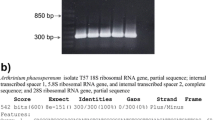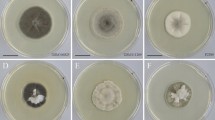Abstract
On the basis of cultural, anatomical, and electrophoretic studies,Myriosclerotinia borealis (=Sclerotinia borealis) is shown to occur on cultivated non-gramineous plants includingIris ensata var.hortensis (Japanese iris),I. pseudoacorus, I. hollandica (Dutch iris), Perko PVH (a hybrid green manure crop betweenBrassica campestris andB. chinensis), Allium fistulosum, andCampanula portenshlagiana. The fungus did not kill these plants, but produced functional sclerotia, capable of carpogenic germination, on decayed leaves or necrotic lesions of overwintered leaves. The fungus seems to act as a saprophyte colonizing senescent leaves and/or as a weak parasite on plants injured by freezing during winter. In culture, the fungus produces discrete tuberoid sclerotia closely attached to the agar surface; rind differentiation is poor on the under surface of sclerotia. Medullary cells are embedded in a gelatinous matrix showing no distinct intercellular spaces. The ectal excipulum of apothecia produced under artificial conditions is composed of globose cells.Myriosclerotinia borealis is thus shown to be very close toCiborinia on the basis of these sclerotial and apothecial characters.
Similar content being viewed by others
Literature cited
Amano, Y. and Ozeki, S. 1981. Winter wheat breeding for resistance to snow mold and cold hardiness. I. Development of testing methods and application for the classification of resistant varieties. Bull. Hokkaido Pref. Agric. Exp. Stn.46: 12–21.
Arseniuk, E. and Macewicz, J. 1992. Scanning electron microscopy of sclerotia ofSclerotinia trifoliorum Erikss. and related species. J. Phytopathol.141: 275–284.
Backhouse, D., Willetts, H. J. and Adam, P. 1984. Electrophoretic studies ofBotrytis species. Trans. Br. Mycol. Soc.82: 625–630.
Benell, A. P., Christopher, P. and Walting, R. 1978. Techniques for routine anatomical studies of dried and fresh basidiomes, using plastic embedding and dichromatic staining. Trans. Br. Mycol. Soc.71, 512–515.
Bensadoun, A. and Weinstein, D. 1976. Assay of proteins in the presence of interfering materials. Anal. Biochem.70: 241–250.
Björling, K. 1952. Über die Entwicklungsgeschite, Variabilität, und Pathogenität vonSclerotinia trifoliorum Erikss. Phytopath. Zeitsch.18: 129–156.
Bruehl, G. W. 1982. Developing wheat resistant to snow mold in Washington State. Plant Disease66: 1090–1095.
Groves, J. W. and Bowerman, C. A. 1955.Sclerotinia borealis in Canada. Can. J. Bot.33: 591–594.
Henderson, S. A. and Lu, B. C. 1968. The use of hematoxylin for squash preparations of chromosomes. Stain Technol.43: 233–236.
Insel, J. P., Huner, N. P. A., Newstead, W. J. and van Huystee, R. B. 1985. Light microscopic and polypeptide analysis of sclerotia from mesophilic and psychrophilic pathogenic fungi. Can. J. Bot.63: 2305–2310.
Jamalainen, E. A. 1949. Overwintering of Gramineae-plants and parasitic fungi. I.Sclerotinia borealis Bubak & Vleugel. J. Sci. Agric. Soc. Finl.21: 125–142.
Jensen, W. A. 1962. Botanical histochemistry. W. H. Freeman, San Francisco.
Kohn, L. M. 1979. A monographic revision of the genusSclerotinia. Mycotaxon9: 365–444.
Lu, B. C. 1962. A new fixative and improved propionocarmine squash technique for staining fungus nuclei. Can. J. Bot.40: 843–847.
Noshiro, M. 1980. On the relation between freezing injury and occurrence ofSclerotinia snow blight disease in grasses. J. Jpn. Grassl. Sci.25: 386–388.
Noshiro, M. and Hirashima, T. 1978. Studies on freezing of pasture species. I. Effect of freezing injury andSclerotinia snow blight disease on wintering of several grasses in Nemuro-Kushiro district. J. Japan Grassl. Sci.23: 289–294.
Ridgway, R. 1912. Color standard and color nomenclature. Published by the author, Washington.
Saito, I. 1974. Ultrastructural aspects of the maturation of sclerotia ofSclerotinia sclerotiorum (Lib.) de Bary. Trans. Mycol. Soc. Japan15: 384–400.
Saito, I. 1977. Studies on the maturation and gernmination of sclerotia ofSclerotinia sclerotiorum (Lib.) de Bary, a causal fungus of bean stem rot. Rep. Hokkaido Pref. Agric. Exp. Stn.26: 1–106.
Saito, I. 1997.Sclerotinia nivalis sp. nov., the pathogen of snow mold of herbaceous dicots in northern Japan. Mycoscience38: 227–236.
Schumacher, T. and Kohn, L. M. 1985. A monographic revision of the genusMyriosclerotinia. Can. J. Bot.63: 1610–1640.
Tomiyama, K. 1955. Studies on the snow blight disease of winter cereals. Rep. Hokkaido Agric. Exp. Stn.47: 1–234.
Ward, E. W. B. 1966. Preliminary studies of the physiology ofSclerotinia borealis, a highly psychrophilic fungi. Can. J. Bot.44: 237–246.
Whetzel, H. H. 1945. A synopsis of the genera and species of the Sclerotiniaceae, a family of stromatic inoperculate discomycetes. Mycologia37: 648–714.
Willetts, H. J. and Bullock, S. 1982. Study on the ontogeny and ultrastructure of the sclerotium ofBotrytis cinerea Pers. ex Nocca & Balbis. Can. J. Bot.44: 237–246.
Author information
Authors and Affiliations
About this article
Cite this article
Saito, I. Non-gramineous hosts ofMyriosclerotinia borealis . Mycoscience 39, 145–153 (1998). https://doi.org/10.1007/BF02464052
Accepted:
Issue Date:
DOI: https://doi.org/10.1007/BF02464052




